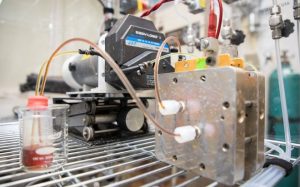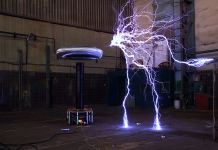Groups of scientists around the world are working on the development of new types of batteries for energy conservation. And if some are asking about increasing the power of the devices, others are more concerned about their environmental friendliness and minimizing the detrimental impact on the environment during disposal.
It is widely known that when filling two vessels with electrolytes having different charges and installing a membrane between them, a current appears. Electrons move between the poles and thereby create electricity – this fact, according to some sources, was known a few thousand years ago. So, most of the world’s luminaries of science use this long-known principle in their attempts to invent a battery of a new generation.
 A group of scientists from Harvard University tried to approach the issue of introducing innovations in energy conservation more responsibly in terms of protecting nature. The inventors proposed a new type of organic batteries, which are not inferior to traditional batteries in efficiency.
A group of scientists from Harvard University tried to approach the issue of introducing innovations in energy conservation more responsibly in terms of protecting nature. The inventors proposed a new type of organic batteries, which are not inferior to traditional batteries in efficiency.
In scientific circles, it is generally accepted that vanadium and bromine, or rather from a compound, will be the best choice in material issues when creating a battery. For use in the battery, these elements are pre-dissolved in acids. It should be noted that such a material for the battery involves the creation of additional protective elements, as it is very corrosive and causes corrosion. In addition, such connections are quite expensive from a financial point of view, which significantly increases the cost of the battery.
Back in 2014, Harvard University launched a major project dedicated to in-depth study of energy-saving organic molecules. In scientific circles, such molecules are called “quinones”. Scientists analyzed and studied about 10 thousand types of different molecules in search of suitable ones.
At the initial stage of development of the organic battery, the inventors replaced the bromine compounds with ferrocyanide. Then, the acid changed to an alkaline solution. Later, by modifying vitamin B2, we managed to abandon caustic formulations, neutral solutions replaced them.
To date, the proud of the Harvard project is an artificially created organic molecule called “Methuselah”. This molecule has striking capacitive characteristics and unique durability. This name is due to the old man, the long-liver of the Bible.
 Scientists claim that the battery using an innovative molecule has loss rates of 0.001 percent during one charging cycle. During one day of work, the battery cannot lose more than 0.01 percent. The molecule “Methuselah ” in the battery is placed in a weak solution of alkali.
Scientists claim that the battery using an innovative molecule has loss rates of 0.001 percent during one charging cycle. During one day of work, the battery cannot lose more than 0.01 percent. The molecule “Methuselah ” in the battery is placed in a weak solution of alkali.
According to preliminary data, battery degradation rates are only 3 percent per year. The competitiveness of the new battery is evident even along with advanced batteries with a traditional structure.
Scientists say that the cost of the device is rather low. This will allow it to be massively introduced into various fields of application.




























